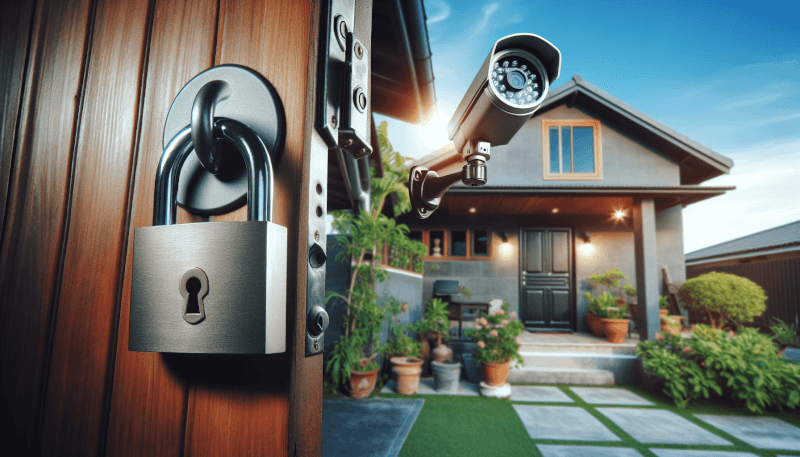In today’s ever-changing world, it’s important to ensure the safety and security of our homes. Whether you’re a prepper or simply someone who wants to feel protected, this guide is here to help you navigate the world of home security. From basic tips for fortifying your doors and windows to advanced strategies for creating a comprehensive security system, we’ve got you covered. Discover practical advice and actionable steps you can take to safeguard your home and loved ones in this Prepper’s Guide to Home Security.

Securing the perimeter
Installing a sturdy fence
When it comes to securing your home, one of the first steps you should take is installing a sturdy fence around your property. A fence acts as a deterrent to potential intruders and establishes a clear boundary between your property and the outside world. Opt for a fence that is at least six feet high to ensure it is not easily scalable. Additionally, choose a fence design that does not provide potential intruders with easy visibility into your property.
Putting up motion sensor lights
Motion sensor lights are an excellent addition to your home security measures. These lights automatically turn on when they detect any motion within their range, alerting you to any potential activity around your home. Install these lights near entry points such as your front and back doors, as well as in areas with limited visibility, such as along the sides of your house or near dark corners. Illuminating these areas can deter intruders and provide you with an added sense of security.
Using security cameras
In today’s digital age, security cameras have become increasingly accessible and affordable for homeowners. Installing security cameras at strategic points around your property can greatly enhance your home security. These cameras act as both a deterrent and a surveillance tool, capturing any suspicious activity that may occur. Place security cameras at key entry points, such as your front door and garage, as well as in areas where valuables are stored. Additionally, consider choosing cameras with night vision capabilities for round-the-clock monitoring.
Adding a gate with a lock
To further secure your property, consider adding a gate with a lock to your perimeter fencing. This provides an additional layer of protection by creating an obstacle that intruders need to overcome in order to access your property. Choose a gate that is sturdy and difficult to climb over or cut through. Install a secure lock to prevent unauthorized access and make sure to consistently lock the gate when it is not in use. This simple addition can significantly enhance your home’s security.
Reinforcing doors and windows
Installing solid core doors
Your home’s doors are crucial points of entry that can be targeted by intruders. To reinforce them, consider installing solid core doors. These doors are made of a dense and sturdy material that is more difficult to break through compared to hollow doors. Reinforced with materials such as metal or fiberglass, solid core doors provide an added layer of protection against forced entry.
Adding deadbolt locks
While many homes come with standard locks on their doors, adding deadbolt locks can greatly improve the security of your entry points. Deadbolt locks are more resistant to tampering and provide greater strength against forced entry attempts. Choose a deadbolt lock that extends at least one inch into the door frame to prevent it from being easily kicked in. Remember to always lock your doors, even when you are at home, to maintain a secure environment.
Using window security film
Windows are another vulnerable point in your home’s security. Strengthen them by applying window security film. This film is a transparent sheet that reinforces the glass, making it more difficult to break. In the event of an attempted break-in, the security film holds the shattered glass in place, preventing easy access for intruders. Window security film is a cost-effective way to enhance the security of your windows without the need for replacing them entirely.
Putting in window bars
For added protection, consider installing window bars on vulnerable windows. Window bars act as a physical barrier, preventing intruders from gaining access to your home through the windows. They are particularly effective on ground-level windows or windows in secluded areas of your home. Choose window bars that are made of strong materials, such as metal, and ensure they are securely attached to the window frame. While window bars can give your home a more fortress-like appearance, they are a highly effective security measure.
Strengthening entry points
Installing a security door
If you want to take the security of your entry points to the next level, consider installing a security door. These doors are specially designed to resist forced entry attempts and are often constructed with reinforced steel or metal frames. Security doors typically feature multiple locking points, making them much more difficult for intruders to breach. Additionally, many security doors come with small peepholes or built-in cameras, allowing you to identify visitors before opening the door.
Using door jammers or barricades
For an added layer of security, door jammers or barricades can be highly effective. These devices prevent doors from being easily opened, even if the lock is picked or forced. Door jammers are often small, portable devices that can be temporarily placed at the base of the door to prevent it from being opened from the outside. Barricades, on the other hand, are more permanent fixtures that can be installed on the inside of the door and can provide a significant physical barrier against unwanted entry.
Adding a sliding door security bar
If your home features sliding glass doors, it is essential to secure them properly. Sliding door security bars can provide an effective means of preventing intruders from accessing your home through these entry points. These bars are adjustable in length and can be placed along the bottom track of the sliding door. When engaged, they create a sturdy block, preventing the door from being easily forced open. Sliding door security bars are relatively inexpensive, making them a practical investment for your home’s security.
Enhancing home alarm systems
Choosing a comprehensive security system
Investing in a comprehensive home alarm system is one of the most effective ways to secure your home. These systems often come with a combination of features, including door and window sensors, motion detectors, and a control panel. When choosing a security system, consider features such as remote monitoring, smartphone integration, and professional monitoring services. A comprehensive security system provides you with peace of mind knowing that your home is being monitored and protected around the clock.
Adding window and door sensors
Window and door sensors are vital components of any home security system. These sensors detect when a door or window is opened, triggering an alert through the security system. Placing these sensors on all accessible windows and doors ensures that any unauthorized entry is immediately detected. Whether you are at home or away, window and door sensors provide an added layer of security and notify you of potential intrusions.
Using glass break sensors
Intruders may attempt to bypass door or window sensors by breaking the glass instead. To counter this, consider adding glass break sensors to your security system. These sensors detect the sound frequency and pattern of breaking glass, triggering an alarm when activated. By placing glass break sensors strategically throughout your home, you can ensure that even if a window is shattered, the alarm system is immediately activated, alerting you and scaring off potential intruders.
Installing security system signs and stickers
While the primary purpose of a security system is to deter intruders, it can also act as a powerful psychological tool. Display visible signs and stickers advertising your security system around the exterior of your home. These symbols indicate to potential intruders that your home is protected and monitored, making it a less attractive target. Even if you do not have a security system, these signs can still serve as a deterrent, creating the impression that your home is well-secured.

Safeguarding valuables
Investing in a fireproof safe
Protecting your valuable belongings is a critical aspect of home security. Safeguard them by investing in a fireproof safe. A fireproof safe provides an added layer of protection against both theft and fire. Choose a safe that is appropriately sized to accommodate your valuable items, such as important documents, jewelry, or cash. Look for safes with certified fire ratings and sturdy locking mechanisms to ensure your belongings remain secure in the event of an emergency.
Using diversion safes
Diversion safes are clever and discreet hiding places for your valuable items. These safes are designed to blend in seamlessly with everyday household objects, making them almost undetectable to intruders. From soda cans to books, diversion safes come in various forms and can be placed inconspicuously throughout your home. Should an intruder enter, they are unlikely to suspect that these items actually hide your most prized possessions.
Creating hidden storage spaces
In addition to using safes, you can create hidden storage spaces within your home. These spaces offer an extra layer of protection for your valuables, as intruders are unlikely to find them during a quick search. For example, consider installing a false bottom in a drawer or building a secret compartment within a closet. By utilizing these hidden spaces, you can keep your valuables hidden and out of sight from potential burglars.
Securing outdoor areas
Trimming trees and shrubs
Landscaping plays a significant role in home security, as overgrown trees and shrubs can provide cover and hiding places for intruders. Keep your outdoor areas well-maintained by regularly trimming trees and shrubs near your home. This not only removes potential hiding spots but also increases visibility from both inside and outside your property. By maintaining a clear line of sight, you can deter intruders and increase the overall security of your home.
Using outdoor security lighting
Outdoor security lighting is an essential element of securing your outdoor areas. Well-lit exteriors discourage trespassers by eliminating potential hiding spots. Install motion-activated lights around your home’s perimeter, driveway, and other key areas. These lights automatically turn on when they detect movement, alerting you to any potential activity. Outdoor lighting provides not only a sense of security but also enhances safety for you and your family when navigating your property at night.
Adding security fences to storage sheds
If you have storage sheds or other external structures on your property, it is important to secure them as well. Install security fences or secure enclosures around these structures to deter intruders. A solid fence around your storage shed restricts access and prevents individuals from easily entering the area. Additionally, consider adding a lock or padlock to the shed itself for an extra layer of security. Don’t overlook the security of your external structures, as they may also house valuable possessions or tools.

Establishing a neighborhood watch
Getting to know your neighbors
Establishing a neighborhood watch program is an effective way to enhance the security of your entire community. Start by getting to know your neighbors and building a sense of trust and camaraderie. Develop relationships with those living nearby by attending community events, organizing block parties, or joining local neighborhood associations. By fostering a strong sense of community, you create an environment where neighbors look out for each other and are more proactive in reporting suspicious activities.
Setting up a communication network
A crucial aspect of a successful neighborhood watch is establishing a communication network. This network allows neighbors to quickly share information and alert each other of any potential security concerns. Set up a phone tree or an online group where neighbors can communicate and stay connected. In case of emergencies or suspicious activities, this network enables the rapid dissemination of information, ensuring that everyone in the neighborhood remains informed and vigilant.
Organizing regular meetings
Regular neighborhood watch meetings are vital for maintaining a strong and proactive community. These meetings provide a platform for discussing recent security concerns, exchanging tips, and brainstorming strategies to improve overall neighborhood safety. Invite local law enforcement officers to attend and provide guidance on crime prevention techniques. By organizing regular meetings, you foster a collaborative environment focused on the security and well-being of everyone in the neighborhood.
Securing utilities
Installing a generator
In emergency situations or during power outages, having a generator can be invaluable for maintaining the security of your home. A generator ensures that critical systems, such as security alarms and lights, remain functional even when the power grid is down. Consult with a professional to determine the appropriate size and type of generator for your needs. Proper installation and regular maintenance are key to ensuring that your generator operates reliably when it is most needed.
Securing propane tanks
If your home utilizes propane for heating or cooking, it is essential to secure your propane tanks to prevent unauthorized use or theft. Install a sturdy lock on the valve or storage compartment of the propane tank to prevent tampering or unauthorized access. Additionally, consider placing a protective cage or barrier around the tank to discourage potential theft attempts. By enhancing the security of your propane tanks, you can minimize potential risks and ensure the safe utilization of this valuable resource.
Protecting electrical equipment
Electrical equipment, such as meters or circuit panels, is essential for your home’s functioning. These components can be tampered with or targeted by intruders looking to disable security systems or disrupt utilities. To secure these critical elements, consider installing secure enclosures or cabinets around them. These barriers prevent easy access and help deter unauthorized interference. Protecting your electrical equipment ensures the uninterrupted operation of your security systems and prevents potential disruptions to your utilities.

Preparing for emergencies
Creating a home emergency plan
A key aspect of home security is being prepared for emergencies. Create a comprehensive home emergency plan that includes protocols for different scenarios, such as natural disasters or intruder situations. Establish designated meeting points, emergency contact lists, and escape routes for each family member. Regularly review and practice this plan with your household members to ensure everyone is familiar with the procedures. By having a well-defined emergency plan, you can respond effectively in times of crisis and prioritize the safety of your family.
Stocking up on emergency supplies
In addition to having an emergency plan, it is crucial to stock up on essential supplies to sustain you and your family during an emergency. Items such as non-perishable food, bottled water, medication, and first aid kits should be readily available. Consider the specific needs of your household, including infants, pets, or individuals with medical conditions, when creating your emergency supply list. Regularly check and replenish these supplies to ensure they are up-to-date and ready for immediate use.
Installing smoke and carbon monoxide detectors
Protecting your home from fire-related emergencies is of utmost importance. Install smoke and carbon monoxide detectors throughout your home to quickly detect any issues and ensure early warning in case of danger. Place these detectors near bedrooms, kitchens, and living areas, as these are common locations for fires to start. Regularly test and maintain these devices to ensure they are functioning properly. Smoke and carbon monoxide detectors are crucial tools in safeguarding your home and the well-being of your loved ones.
Enhancing personal safety
Taking self-defense classes
While securing your home is essential, it is also important to invest in your personal safety. Improve your self-defense skills by taking self-defense classes. These classes teach you effective techniques for protecting yourself and give you the confidence needed to handle potential threats. Research local martial arts studios or self-defense programs in your area and consider enrolling in a course. By learning to defend yourself properly, you enhance your personal safety wherever you may be.
Installing security screens
Security screens are a practical addition to your home’s security measures. These screens are made of reinforced materials, such as stainless steel, and can be installed on windows and doors. They provide an additional layer of protection by creating a physical barrier that intruders need to overcome before gaining access to your home. Security screens also allow you to keep your doors and windows open for ventilation while maintaining a secure environment.
Using safe rooms or panic rooms
For ultimate personal safety, consider creating a safe room or a panic room within your home. These dedicated spaces provide a secure retreat in case of emergencies, such as a home invasion or natural disaster. Safe rooms are reinforced, fortified areas where you can seek refuge until help arrives. Stock these rooms with emergency supplies and communication devices to ensure you can communicate with authorities if needed. Safeguarding your personal safety with a safe room provides you with peace of mind during high-stress situations.
By implementing the home security measures outlined in this article, you can significantly enhance the safety and protection of your property. From securing your perimeter with fences and lights to reinforcing doors and windows, every step you take contributes to a more secure home. By investing in home alarm systems, safeguarding valuables, and securing outdoor areas, you create additional layers of protection. Establishing a neighborhood watch, securing utilities, and preparing for emergencies further strengthen your home security. Finally, enhancing personal safety through self-defense classes, security screens, and safe rooms ensures that your overall safety is prioritized. Take proactive steps today to secure your home and enjoy peace of mind knowing that you have taken the necessary precautions to protect your property and loved ones.



